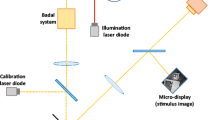Abstract
Experiments under a variety of open and closed loop feedback configurations demonstrate that accommodative responses to target blur are equivalent to those to defocus blur; this supports blur as the ‘sufficient’ neurological stimulus to accommodations. The hunting action of accommodation compensates for the even error aspect of blur and also adaptively minimizes any close loop error components while finally accepting open loop components.
Similar content being viewed by others
References
Allen, M.J. The stimulus to accommodation.Amer. J. Optom.: 422–431 (1954).
Alpern, M. Is accommodation related merely to accommodation stimulus?AMA Arch. Ophthal. 60:358–360 (1958).
Badal, J. Rauvel optometric: Donnant à la fais et dans une seule operation, la mesure de la refraction oculaire et celle de l'acuite visuelle.Ann. Oculist. 175:5–13 (1976).
Baxter, DeYoung, St. George & Shurcliff. Focusing a high-power microscope.J. Optical Soc. Amer. 47:76–80 (1957).
Bliss, J.D. & H.D. Crane. Optical detector for objects within an adjustable range.J. Optical Soc. Amer. 54:1261–1266 (1964).
Bliss, J.C. & H.D. Crane. Relative motion and nonlinear photocells in optical image processing. Optical and Electro-Optical Information Processing. M.I.T. Press, Boston (1965).
Bliss, J.C. & H.D. Crane & B.D. King. Ranging instrument. U.S. Patent No. 3, 385, 159 (1968).
Brodkey, J. & L. Stark. Accommodative convergence: an adaptive nonlinear control system.IEEE Trans. Systems, Science and Cybernetics, SSC- 3:121–133 (1967).
Buchl, K. Focus detector as an aid for focusing a laser on a target.Appl. Optics 9:113–114 (1970).
Campbell, F.W.. Accommodation reflexBrit. Orth. J. 11:13–17 (1954).
Campbell, F.W. & G. Westheimer. Factor influencing accommodation responses of the human eye.J. Optical Soc. Amer. 49:568–571 (1959).
Campbell, F.W. & G. Westheimer. Dynamics of accommodation responses of the human eye.J. Physiol. 151:285–295 (1960).
Cornsweet, T.N. & H.D. Crane. Training the visual accommodation system.Vision Res. 13:713–715 (1973).
Graig, D.R.. Image sharpness meter.Photographic Science and Engineering 5:337–342 (1961).
Crane, H.C. & G.L. Pressman. Reciprocal optical system for measuring the state of focus of reflected images.J. Optical Soc. Amer. 58:1607–1615 (1968).
Crane, H.D. A theoretical analysis of the visual accommodation system in human, NASA report NAS 2-2760, Stanford Res. Inst. (1966).
Crane, H.D. & T.N. Cornsweet. Ocular-focus stimulator.J. Optical Soc. Amer. 60: (1970).
Crawley, G. The canon autofocus.Br. J. Photography, 278–280 (1963).
Davson, H. The Physiology of the Eye, Academic Press, New York, 3rd ed. (1972).
Engel, G.R. Simulating accommodation by image autocorrelation.Amer. J. Optom. 49:496–503 (1972).
Farbar, E. What's the story behind Nikon's auto-focusing lens.Modern Photograph: 48–53 (1971).
Fincham, E.F. The mechanism of accommodation.Brit. J. Ophthal. Monograph, Supplement VIII (1937).
Fincham, E.F. The accommodation reflex and its stimulus.Brit. J. Ophthal. 35:381–393 (1951).
Fry, G.A. Blur of the retinal image. The Ohio State University Press, Columbus, Ohio (1955).
Fujii, K., K. Kondo & T. Kasai. An analysis of the human eye accommodation system. Report of Osaka University, Japan (1969).
Fujii, K. & T. Kasai. Image processing mechanism in human eye accommodation. Report of Osaka University, Japan (1969).
Fujii, K. & T. Kawai. Image processing mechanism in human eye accommodation. Report of Osaka University, Japan (1969).
Hand, A.J. The lens that focuses itself. Popular Science (1970).
Heath, G.G. Components of accommodation.Amer. J. Optom. 13:569–579 (1956).
Heath, G.G. The time course of night and space myopia. Aero Med. Res. Lab. report No. AMRL-TDR-62-80, Ohio (1962).
Kallmann, H.E. Optar, a method of optical automatic ranging, as applied to a guidance device for the blind.Proc. of IRE: 1438–1446 (1954).
Kasai, T., K. Kondo, M. Sekiguchi & K. Fujii. Influence of the depth of focus on the human eye accommodation. Technology Report of Osaka University, Japan, Vol. 20, No. 925 (1970).
Marg, E. An investigation of voluntary as distinguished from reflex accommodation.Amer. J. Opt. andArch. Amer. Acad. Opt. 28: 347–356 (1956).
Mellerio, J. Ocular refractions at low illuminations.Vision Res. 16:217–237 (1965).
Morgan, M.W. Stimulus to and response of accommodation.Can. J. Optom. 30:71–78 (1968).
Ogle, K.N. & J.T. Schwartz. Depth of focus of the human eye.J. Opt. Soc. Amer. 49:273–280 (1959).
O'Neill, W.D. & L. Stark. Triple fuction ocular monitor.J. Opt. Soc. Am. 58:570–573 (1968).
Oshima, S. Studies on the depth of focus of the eye.Jap. J. Ophthal. 2:63–72 (1958).
Phillips, S.R., D. Shirachi & L. Stark. Analysis of accommodation response times using histogram information.Amer. J. Opt. 49:389–401 (1972).
Phillips, S.R. Ocular neurological control systems: accommodation and the near response triad. Ph.D. dissertation, University of California, Berkeley (1974).
Randle, R.J. Volitional control of visual accommodation. Advisory Group of Aerospace Res. and Dev. (AGARD), Cof. Prox. 82, Garmisch-Partenkirchen, Germany, September 15–17 (1970).
Randle, R.J. & M.R. Murphy. The dynamic response of visual accommodation over a seven-day period.Am. J. Optom. & Physiol Optics 51:530–544 (1974).
Shirachi, D. Nonlinear control of human visual accommodation. Ph.D. dissertation, University of California, Berkeley (1974).
Smith, K.U. & W.M. Smith. Perception and Motion: An Analysis of Space-Structured Behavior. Saunders (1962).
Smithline, L.M. Accommodative response to blur.J. Opt. Soc. Amer. 64:1512–1516 (1974).
Stark, L. & Y. Takahashi. Absence of an odd-error signal mechanism in human accommodation. IEEE Trans. 138 (1965).
Toates, F.M. Accommodation function of the human eye.Physiol. Rev. 52:828–863 (1972).
Troelstra, A., B.L. Zuber, Miller & L. Stark. Accommodation tracking—a trial-anderror function.Vision Res. 4:585–599 (1964a).
Troelstra, A., W.D. O'Neill & L. Stark. Vision during manned booster operation. NASA Report, N.A.S. 8-20381 (1964b).
Whiteside, T.C.D. Problems of vision in aviation.Amer. J. Opt. 36:327–333 (1959).
Whiteside, T.C.D. Vision in an empty field. Flying personnel research committee report, No. 854, R.A.F. Inst. Av. Med. (1953).
Whitney, D.B. An automatic focusing device for ophthalmic lenses.Amer. J. Optom. 35.April (1958).
Westheimer, G. The effect of spectacle lenses and accommodation on the depth of focus of the eye.Amer. J. Opt. 30:513–519 (1953).
Author information
Authors and Affiliations
Additional information
We acknowledge partial support from NIH Training Grants in Bioengineering and in Physiological Optics, and the helpful discussion with our colleagues, Prof. V.V. Krishnan and Dr. Douglas Shirachi.
Rights and permissions
About this article
Cite this article
Phillips, S., Stark, L. Blur: A sufficient accommodative stimulus. Doc Ophthalmol 43, 65–89 (1977). https://doi.org/10.1007/BF01569293
Issue Date:
DOI: https://doi.org/10.1007/BF01569293




